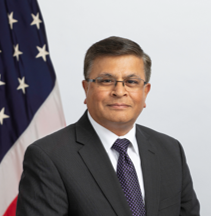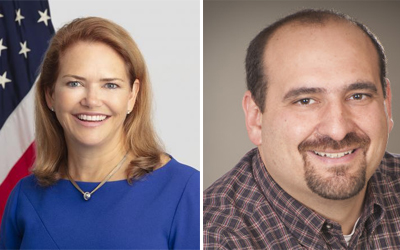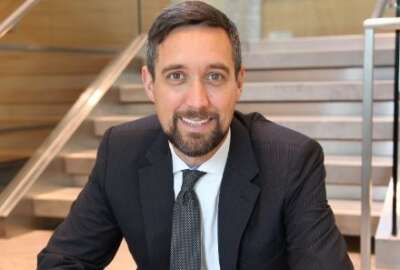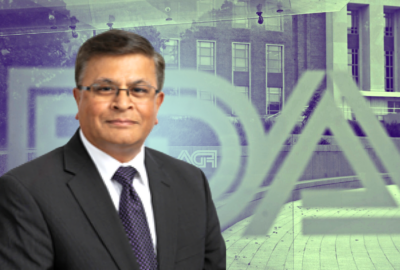Through new Office of Digital Transformation, FDA putting business ahead of IT
Vid Desai, FDA’s chief information officer, said the new Office of Digital Transformation will improve their ability to govern more effectively, reduce the...
Data and science are at the center of the mission of the Food and Drug Administration.
This is why the agency created the new Office of Digital Transformation. It is the final step in a two-year effort to reorganize how the FDA uses data and technology to protect and promote public health.
Vid Desai, FDA’s chief information officer, said the Office of Digital Transformation (ODT) will drive change down to the individual centers and offices to improve their mission delivery.

“Science and data are at the heart of everything we do as an agency. So this reorganization basically recognizes the importance and the strategic role that IT plays in all aspects of the agency’s operations. Good IT and data management will fundamentally improve and help scale what FDA does as part of its work, and we’re taking an integrated approach to enterprise technology, data and cybersecurity,” Desai said on Ask the CIO. “We needed to elevate the stature of the IT organization. That was one of the primary reasons for announcing the reorganization. It elevates the agency’s IT, data and cybersecurity to the agency level, which was something that we’ve never had within the FDA. It improves our ability to govern more effectively, reduce the duplication and the fragmentation that occurs when we work in more of an organizational siloed manner.”
The FDA announced this reorganization in September, which included naming Desai as its new CIO, making him the leader of ODT and bringing all the CIO functions under the new organization.
Through ODT, Desai, who joined the FDA in 2019 as its chief technology officer after spending his entire career in the private sector, will have more authority and responsibility to improve and consolidate enterprisewide technology. He said one of his main goals in 2022 is to reduce fragmentation and duplications across the offices and centers.
“When you’re driving change, it’s important to be able to do that from a place where you can govern more effectively. When you’re buried several levels down in the organization, it’s harder to impose that governance, and that’s the reason why it was important for it to be elevated,” he said. “We have a full seat at the table where we can be part of the discussion that formulates the strategic direction of the agency, and then we can look at how IT can support those strategies and the priorities we are establishing at the executive level.”
The other big change is how the FDA will apply technology to mission challenges. Desai said too often in the past efforts were not focused enough on the outcomes or what the agency was trying to achieve.
“We’re now taking an approach where we’re starting with the data, what can we do from a technology perspective to create good usable data because, frankly, when we put data to use, great things happen from a business process perspective, from an operations perspective, so our fundamental principle behind everything we do in IT is to start looking at things from the perspective of how can we create, process and use data in the most effective manner,” he said. “The other area that we’re also prioritizing is too often in IT we do things that are not very well aligned with business priorities or business processes. Given the elevation of the organization and having representation at the very top, we are now making sure that everything we do in IT is very tightly aligned with our business priorities and that IT helps us eliminate waste.”
Enterprise business strategy
That waste came, in part, from the fragmentation and lack of standardization across the agency. Desai said he’s not pushing for a one-size-fits-all approach for the entire agency, especially around mission-focused technology efforts.
“It doesn’t make sense for us to do those common things in a fragmented siloed manner. It’s a lot more efficient for us to pull those at the enterprise level and do them in a consistent common manner, which is what we’re trying to do through the governance approach. We want to take this very balanced approach,” he said. “Where we have to be unique, either because of regulations or statutory requirements, we will continue doing those in the center specific ways. But the activities that we can and do in a more common way across the enterprise, we want to do that in a very consistent, standardized, efficient way.”
One way Desai is creating that efficient and standardized approach to enterprise IT services is through a new enterprise business strategy. He said it’s a way for operational offices and his office to align their priorities to create a strategic plan and work through a business transformation team.
“The one point that I keep emphasizing is really having a tight alignment between what IT does and what the business needs. This enterprise transformation operation team that we’re kicking off is an area that supplements or supports much of what we’re trying to drive from an IT strategy side to bring the business alignment and the IT alignment tightly together,” he said. “As part of the business transformation team, we’ve got a business leader leading that activity, reporting directly to the commissioner. They’re working across all of our centers to start identifying the set of priorities, helping pull what business processes may be common across those business needs and then working with IT to see how we can help support those common enterprise business processes. It needs to be something completely independent of IT, and should have a full representation from the business side.”
This way, Desai said, the business priorities and processes aren’t looked at from only a technology perspective, but the focus is mainly on what makes sense from the business perspective and how can IT support those goals.
24 different cloud instances
Of course, underlying this business-first focus is the network that these applications will run on. Desai said the FDA is taking a cloud-first, cloud-smart approach to modernization, and plans to either move on-premise applications to the cloud or develop new ones so they are not lifting-and-shifting legacy applications that may or may not work well in the cloud.
“The other area that I just want to put some color too is if you think about the changes that are happening within the technology area from a cybersecurity and network perspective, primarily driven by the cloud, as well as changes are happening in the cybersecurity area, they fundamentally require us to rethink everything,” he said. “It literally requires us to rethink the way we do over networks. The way we do our data centers, and the way we implement the cybersecurity without a hard perimeter. All of that requires a very different approach. In the technology world, we hear a lot of talk around the zero trust, which I think is absolutely the right model. But when you look at the details behind that, it is completely different to how we’ve done cybersecurity in the past.”
Currently, the FDA is managing about 75 applications across 24 different cloud environments ranging from the big platforms like Microsoft Azure, Salesforce or Amazon Web Services to smaller ones that meet individual office’s needs.
“We’ve embarked on what we call a cloud forward strategy where any new activity that we initiate the first question we ask is ‘why shouldn’t this be done in the cloud? Or what are the barriers to doing this in the cloud?’ In fact, I would say that in the last 12-to-18 months, I cannot think of any application that we have embarked on were we basically chose to do that,” he said. “We are now increasingly and primarily leveraging the cloud as our preferred environment. As we rethink over legacy environment and we modernize the legacy applications over a progression, the cloud will continue to accelerate.”
Copyright © 2025 Federal News Network. All rights reserved. This website is not intended for users located within the European Economic Area.
Jason Miller is executive editor of Federal News Network and directs news coverage on the people, policy and programs of the federal government.
Follow @jmillerWFED








